Understanding your vehicle’s health is becoming increasingly accessible thanks to On-Board Diagnostics II (OBD2). At the heart of this system lies the standardized 16-pin interface, a crucial component that allows communication between diagnostic tools and your car’s computer. This article delves into the world of OBD2, focusing on this essential 16-pin connector and its role in accessing valuable vehicle data through your OBD2 cable.
What is OBD2 and Why the 16-Pin Interface Matters?
OBD2 is essentially your car’s self-reporting system. It’s a standardized protocol implemented in most modern vehicles, designed to monitor emissions and engine performance. When that check engine light flickers on your dashboard, OBD2 is the system flagging a potential issue. To access this diagnostic information, mechanics and car enthusiasts alike rely on the 16-pin interface, also known as the OBD2 connector or Data Link Connector (DLC).
This 16-pin interface is not just any connector; it’s a precisely engineered port that serves as the physical gateway to your vehicle’s diagnostic data. Located typically within reach of the driver’s seat, this standardized connector allows you to plug in an OBD2 scanner or cable, initiating communication with your car’s onboard computer. Through this 16-pin interface, you can retrieve diagnostic trouble codes (DTCs), monitor real-time sensor data, and gain insights into your vehicle’s operational status.
Understanding OBD2: The Malfunction Indicator Light (MIL) and the Scan Tool connected to the 16-pin OBD2 interface.
Does Your Car Have a 16-Pin OBD2 Interface?
The good news is, if you own a relatively recent non-electric car, the answer is almost certainly yes. The standardization of OBD2, and consequently the 16-pin interface, has been progressively mandated across the globe. While older vehicles might feature different diagnostic connectors, the 16-pin OBD2 became the norm for passenger cars and light trucks.
To quickly check if your vehicle is equipped with the standard 16-pin interface for OBD2, consider these guidelines based on where and when your car was originally purchased:
 Does My Car Have OBD2?
Does My Car Have OBD2?
OBD2 Compliance Timeline: Check if your car, based on purchase location and year, likely has the 16-pin OBD2 interface.
However, even with a 16-pin interface present, especially in older models, it’s not guaranteed to be fully OBD2 compliant. Some manufacturers might have incorporated the 16-pin connector before the full OBD2 standard was universally adopted. If uncertainty remains, consulting your vehicle’s manual or using online resources that decode VIN information can provide definitive confirmation of OBD2 compliance and the presence of a functional 16-pin interface.
A Brief History of OBD2 and the 16-Pin Connector
The journey to the standardized 16-pin interface and OBD2 began in California, driven by the California Air Resources Board (CARB). In the early 1990s, CARB mandated on-board diagnostics for emission control in all new vehicles sold in California, starting from 1991.
The Society of Automotive Engineers (SAE) played a crucial role in formalizing this, recommending the OBD2 standard. A key element of this standardization was the 16-pin OBD2 connector, officially standardized as SAE J1962, ensuring uniformity across different vehicle manufacturers. This standardization included not only the physical 16-pin interface but also Diagnostic Trouble Codes (DTCs), making vehicle diagnostics more consistent and accessible.
The rollout of OBD2 and the 16-pin interface was phased, becoming increasingly mandatory over time:
- 1996: OBD2 mandated in the USA for cars and light trucks, solidifying the use of the 16-pin interface.
- 2001: Required in the EU for gasoline cars, extending the adoption of the 16-pin interface globally.
- 2003: EU mandate expanded to include diesel cars (EOBD), further cementing the 16-pin interface as the standard.
- 2005: OBD2 required in the US for medium-duty vehicles, demonstrating the expanding scope of the 16-pin interface.
- 2008: US vehicles mandated to use ISO 15765-4 (CAN) as the OBD2 communication protocol, further defining the signals transmitted through the 16-pin interface.
- 2010: OBD2 became mandatory for heavy-duty vehicles in the US, universally establishing the 16-pin interface for vehicle diagnostics.
OBD2 History: From emission control origins to the widespread adoption of the 16-pin interface.
OBD2 Timeline: A visual representation of the historical milestones in OBD2 adoption and the 16-pin connector.
OBD2 Future: Envisioning OBD3, remote diagnostics, and the evolving role of the diagnostic interface.
The Future of OBD2 and the 16-Pin Interface
While the 16-pin interface and OBD2 remain the standard for accessing vehicle diagnostics, the automotive landscape is evolving, particularly with the rise of electric vehicles (EVs). Interestingly, legislated OBD2 primarily targeted emissions control, which means electric vehicles, having no combustion engines, are not obligated to support OBD2 in the traditional sense. Consequently, many modern EVs deviate from standard OBD2, often using OEM-specific protocols and communication methods, even if they might still incorporate a 16-pin interface for other purposes.
However, for traditional combustion engine vehicles, OBD2 and the 16-pin interface are expected to persist. Efforts are underway to enhance OBD communication through protocols like WWH-OBD (World Wide Harmonized OBD) and OBDonUDS (OBD on UDS). These aim to improve data richness and streamline diagnostics by leveraging the UDS protocol, while still potentially utilizing the familiar 16-pin interface.
Looking further ahead, the concept of OBD3 envisions integrating telematics into vehicles. This could involve adding a radio transponder to vehicles, enabling wireless transmission of VIN and DTCs to a central server for remote diagnostics and emission monitoring. While the physical 16-pin interface might still be present for local diagnostics, OBD3 could usher in an era of connected car diagnostics, potentially reducing the reliance on physically connecting to the 16-pin interface for routine checks.
However, the proposal by some automotive industry segments to limit third-party access to OBD2 data by “turning off” functionality during driving and centralizing data collection raises questions about the future of open access through the 16-pin interface. This shift could impact the aftermarket OBD2 service and data-driven economy built around accessing vehicle data via the 16-pin interface. Whether this trend gains momentum remains to be seen, but it highlights potential challenges to the current ecosystem surrounding OBD2 and its accessible 16-pin interface.
OBD2 Future in EVs: The potential shift away from standard OBD2 access in electric vehicles and implications for the 16-pin interface.
Become a CAN Bus Expert with our ‘Ultimate CAN Guide’
Want to dive deeper into the technology underpinning OBD2?
Our comprehensive 160+ page PDF guide offers 12 simple introductions to CAN bus and related technologies:
Download now
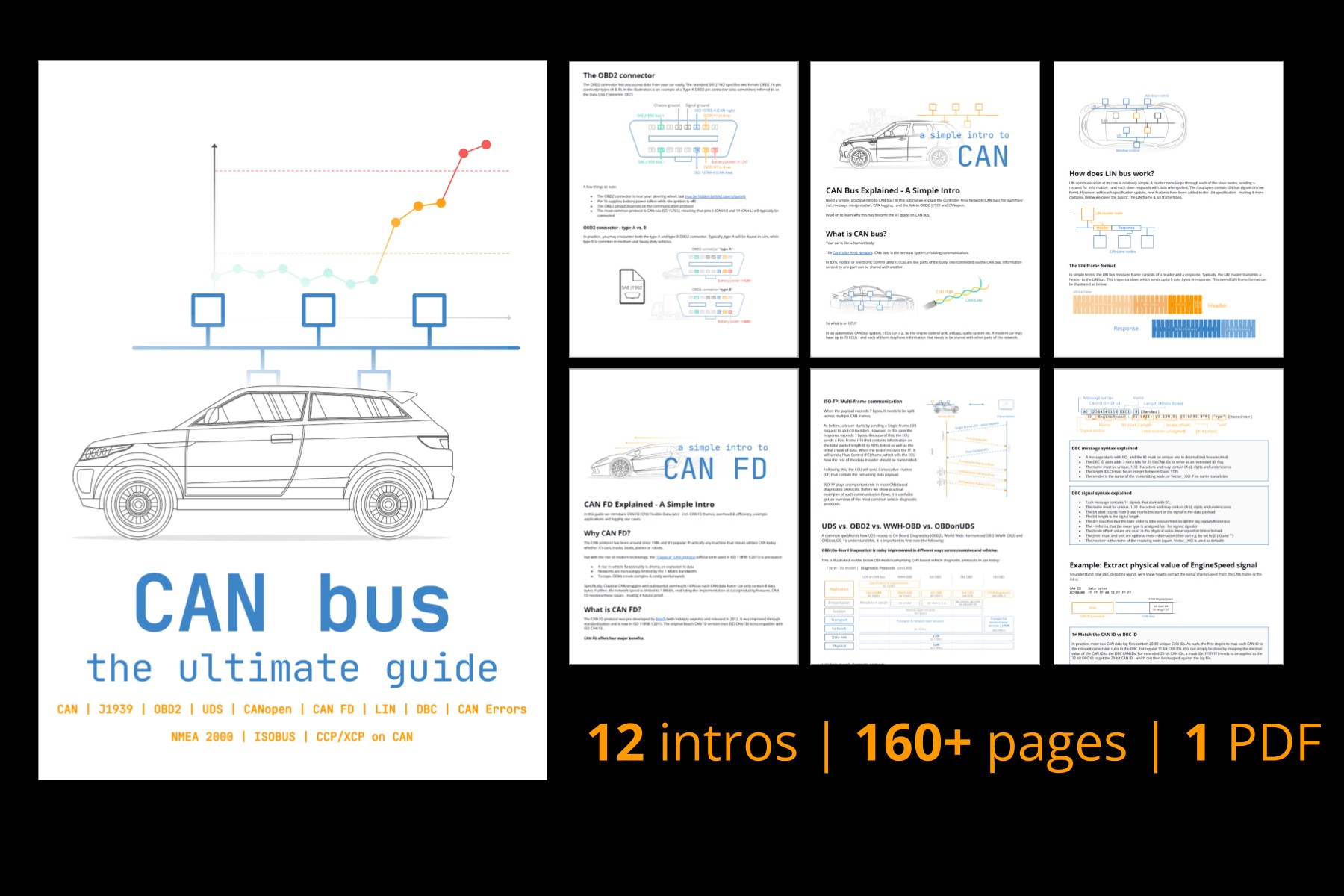 CAN Bus – The Ultimate Guide Tutorial PDF
CAN Bus – The Ultimate Guide Tutorial PDF
OBD2 Standards and the 16-Pin Connector
OBD2 operates as a higher-layer protocol, a “language” for diagnostics, while CAN (Controller Area Network) bus acts as the communication method, the “phone line”. Similar to other CAN-based protocols like J1939, CANopen, and NMEA 2000, OBD2 relies on specific standards that define various aspects, including the 16-pin OBD2 connector, lower-layer protocols, and OBD2 Parameter IDs (PIDs).
These standards can be visualized using the 7-layer OSI model, highlighting the layered communication architecture. Notably, both SAE (primarily US standards) and ISO (international standards) contribute to OBD2 specifications. For instance, SAE J1979 and ISO 15031-5, as well as SAE J1962 and ISO 15031-3, are technically near-equivalent standards covering different aspects of OBD2, including the 16-pin connector.
OBD2 and CAN Bus in the OSI Model: Visualizing the layered standards underpinning OBD2 communication through the 16-pin interface.
OBD2 Connector Pinout: Detailed diagram of the 16-pin OBD2 connector (Type A), highlighting pin functions.
The 16-Pin OBD2 Connector [SAE J1962 / ISO 15031-3]
The 16-pin OBD2 connector is your physical access point to your car’s data. Specified by SAE J1962 and ISO 15031-3, this connector ensures a standardized interface into your car OBD2 cable, enabling seamless communication with diagnostic tools.
Typically located near the steering wheel, though sometimes hidden under a panel, the 16-pin interface follows a defined pinout. Key features of the 16-pin OBD2 connector include:
- Accessibility: Designed for easy access, usually within the driver’s compartment.
- Pin 16: Battery Power: Provides battery power, often active even when the ignition is off, to power OBD2 devices connected via the 16-pin interface.
- Protocol Dependent Pinout: The function of specific pins within the 16-pin interface can vary slightly depending on the communication protocol used by the vehicle.
- CAN Bus Integration: In modern vehicles, CAN bus is the dominant protocol, meaning pins 6 (CAN-High) and 14 (CAN-Low) of the 16-pin interface are typically dedicated to CAN communication.
OBD2 Connector Types: Type A vs. Type B and the 16-Pin Interface
While both Type A and Type B 16-pin OBD2 connectors adhere to the SAE J1962 standard, they cater to different vehicle categories. Type A is commonly found in passenger cars and light-duty vehicles, while Type B is prevalent in medium and heavy-duty vehicles.
Visually, both types maintain the 16-pin interface but differ in power supply and physical keying. Type A typically provides 12V power, while Type B supplies 24V. Baud rates can also differ, with cars often using 500K and heavy-duty vehicles frequently employing 250K (though 500K support is increasing).
A key visual differentiator is the interrupted groove in the middle of the Type B 16-pin interface, which prevents a Type A connector from being fully inserted. However, a Type B OBD2 adapter cable is generally designed to be compatible with both Type A and Type B sockets due to its accommodating connector design.
OBD2 Connector Types: Type A and Type B 16-pin OBD2 connectors, highlighting differences in power and physical keying.
OBD2 vs. CAN Bus: Illustrating the relationship between OBD2 protocol and CAN bus communication within the vehicle’s network.
OBD2 and CAN Bus Communication via the 16-Pin Interface [ISO 15765-4]
Since 2008, CAN bus (ISO 11898) has become the mandatory lower-layer protocol for OBD2 in US vehicles, as defined by ISO 15765. This standard, often called Diagnostics over CAN (DoCAN), specifies how OBD2 communication is conducted over the CAN bus through the 16-pin interface.
ISO 15765-4 outlines specific restrictions and guidelines for using CAN bus for diagnostics, focusing on the physical, data link, and network layers. Key aspects include:
- Bit-rate Standardization: CAN bus bit-rate must be either 250K or 500K for OBD2 communication via the 16-pin interface.
- CAN ID Flexibility: Supports both 11-bit and 29-bit CAN identifiers for OBD2 messages transmitted through the 16-pin interface.
- Dedicated CAN IDs: Specific CAN IDs are reserved for OBD requests and responses exchanged via the 16-pin interface.
- Data Frame Size: Diagnostic CAN frames are limited to a data payload of 8 bytes when communicating through the 16-pin interface.
- Cable Length Limit: The OBD2 adapter cable connected to the 16-pin interface should not exceed 5 meters in length.
CAN Identifiers for OBD2 Communication via the 16-Pin Interface
OBD2 communication via the 16-pin interface is based on a request-response model. In most cars, 11-bit CAN IDs are used. ‘Functional Addressing’ utilizes CAN ID 0x7DF, broadcasting a request to all OBD2-compliant ECUs (Electronic Control Units) to check if they have data for the requested parameter. ‘Physical Addressing’, less frequently used, employs CAN IDs 0x7E0-0x7E7 for direct requests to specific ECUs through the 16-pin interface.
ECUs respond with 11-bit IDs in the range 0x7E8-0x7EF. The most common response ID is 0x7E8 (Engine Control Module – ECM), followed by 0x7E9 (Transmission Control Module – TCM).
In some vehicles, particularly vans and medium/heavy-duty vehicles, 29-bit extended CAN identifiers might be used for OBD2 communication through the 16-pin interface. Here, the ‘Functional Addressing’ CAN ID is 0x18DB33F1. Responses are typically seen with CAN IDs ranging from 0x18DAF100 to 0x18DAF1FF, often 0x18DAF110 and 0x18DAF11E. These 29-bit IDs are sometimes represented in J1939 PGN format, specifically PGN 0xDA00 (55808), which is designated in the J1939-71 standard as ‘Reserved for ISO 15765-2’.
OBD2 Request/Response Frames: Illustrating the communication flow via the 16-pin interface, with request and response frames.
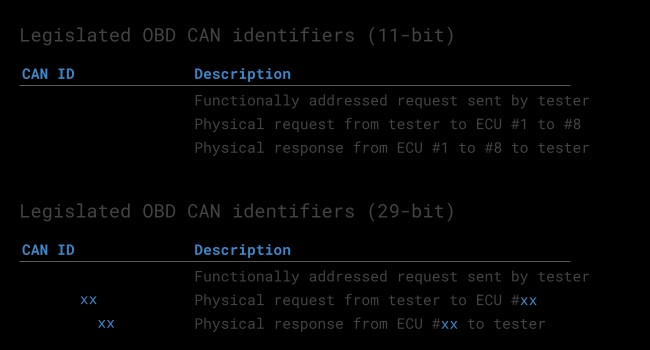 OBD2 OBD CAN bus Identifiers 7DF 7E8 7E0
OBD2 OBD CAN bus Identifiers 7DF 7E8 7E0
OBD2 vs. Proprietary CAN: Differentiating between standardized OBD2 data accessed via the 16-pin interface and OEM-specific CAN data.
OBD2 vs. OEM-Specific CAN Protocols and the 16-Pin Interface
It’s crucial to understand that OBD2 is an additional protocol layered on top of the vehicle’s core communication network. Vehicle ECUs primarily rely on proprietary CAN protocols defined by the Original Equipment Manufacturer (OEM) for their internal operations. These OEM-specific protocols, often unique to brand, model, and year, handle critical vehicle functions. Accessing and interpreting this OEM data is generally restricted unless you possess OEM diagnostic tools or engage in reverse engineering.
When you connect a CAN bus data logger to your car’s 16-pin OBD2 interface, you might observe this OEM-specific CAN data, typically broadcast at high rates. However, many newer vehicles incorporate a ‘gateway’ module that filters data access through the 16-pin interface, primarily allowing OBD2 communication and blocking direct access to the underlying OEM CAN data.
Think of OBD2 as a standardized diagnostic “overlay” accessible via the 16-pin interface, existing alongside and separate from the OEM’s proprietary communication network that governs the vehicle’s core functions.
Bit-rate and ID Validation for OBD2 via the 16-Pin Interface
As OBD2 can utilize two bit-rates (250K, 500K) and two CAN ID lengths (11-bit, 29-bit), a total of four combinations exist. Modern cars commonly use 500K and 11-bit IDs. External diagnostic tools should systematically validate these parameters when establishing communication through the 16-pin interface.
ISO 15765-4 provides a recommended initialization sequence to determine the correct combination. This method leverages the mandatory support for OBD2 mode 0x01 PID 0x00 in compliant vehicles and the detection of CAN error frames when using an incorrect bit-rate.
More recent versions of ISO 15765-4 account for vehicles supporting OBD communication via OBDonUDS in addition to OBDonEDS. While this article primarily focuses on OBD2/OBDonEDS (OBD on Emission Diagnostic Service), it’s worth noting WWH-OBD/OBDonUDS (OBD on Unified Diagnostic Service) used in EU trucks/buses. To differentiate between these protocols, diagnostic tools may send UDS requests via the 16-pin interface to test for OBDonUDS support.
In practice, OBDonEDS (also known as OBD2, SAE OBD, EOBD, or ISO OBD) is prevalent in most non-EV cars, while WWH-OBD is mainly found in EU trucks and buses.
OBD2 Bit-rate and CAN ID Validation Flowchart: Illustrating the process of automatically detecting the correct communication parameters via the 16-pin interface.
Five Lower-Layer OBD2 Protocols: Highlighting CAN (ISO 15765) and other historical protocols used with the 16-pin OBD2 interface.
Five Lower-Layer OBD2 Protocols and the 16-Pin Interface
While CAN (ISO 15765) is now dominant, particularly in vehicles equipped with the 16-pin interface post-2008, older cars might utilize one of four other lower-layer protocols for OBD2. Examining the pinout of the 16-pin connector in older vehicles can sometimes provide clues about the protocol in use.
- ISO 15765 (CAN bus): The prevailing protocol in modern vehicles with the 16-pin interface, mandatory in US cars since 2008.
- ISO 14230-4 (KWP2000): Keyword Protocol 2000, common in 2003+ cars, especially in Asia, potentially using the 16-pin interface.
- ISO 9141-2: Used in EU, Chrysler, and Asian cars during 2000-2004, possibly found with the 16-pin interface.
- SAE J1850 (VPW): Primarily used in older General Motors (GM) vehicles, potentially utilizing the 16-pin interface.
- SAE J1850 (PWM): Predominantly used in older Ford vehicles, also potentially found with the 16-pin interface.
ISO-TP for OBD2 Message Transport via the 16-Pin Interface [ISO 15765-2]
All OBD2 data exchanged through the 16-pin interface over CAN bus relies on ISO-TP (ISO 15765-2), a transport protocol enabling transmission of payloads exceeding the 8-byte CAN frame limit. This is essential for OBD2 functions like retrieving the Vehicle Identification Number (VIN) or Diagnostic Trouble Codes (DTCs) via the 16-pin interface. ISO 15765-2 handles segmentation, flow control, and reassembly of these larger messages.
However, many OBD2 data transmissions are single-frame, fitting within a single CAN frame. In these cases, ISO 15765-2 defines the ‘Single Frame’ (SF) format. The first data byte (PCI field) indicates the payload length, leaving 7 bytes for OBD2-related data within the CAN frame sent through the 16-pin interface.
ISO-TP Frame Types: Illustrating Single Frame and multi-frame types used for OBD2 communication via the 16-pin interface.
The OBD2 Diagnostic Message Structure via the 16-Pin Interface [SAE J1979, ISO 15031-5]
To understand OBD2 communication on CAN bus via the 16-pin interface, let’s examine a simplified ‘Single Frame’ OBD2 CAN message. An OBD2 message consists of a CAN identifier, data length (PCI field), and the data payload. The payload is further structured into Mode, Parameter ID (PID), and data bytes.
OBD2 Message Structure: Breakdown of an OBD2 CAN message transmitted via the 16-pin interface, showing Mode, PID, and data bytes.
Example: OBD2 Request/Response via the 16-Pin Interface
Consider a practical example: requesting ‘Vehicle Speed’ via the 16-pin interface. An external tool sends a request message with CAN ID 0x7DF and a 2-byte payload: Mode 0x01 and PID 0x0D. The car responds with CAN ID 0x7E8 and a 3-byte payload, including the speed value in the 4th byte, 0x32 (decimal 50).
By consulting OBD2 PID documentation, we decode 0x32 as 50 km/h for Vehicle Speed. This simple exchange demonstrates the fundamental request-response communication over the 16-pin interface.
OBD2 Request/Response Example: Requesting Vehicle Speed (PID 0x0D) via the 16-pin interface and receiving the speed value.
OBD2 PID 0x0D: Decoding the Vehicle Speed PID and its data representation in an OBD2 response.
OBD2 Services (Modes): Overview of the 10 standardized OBD2 diagnostic services accessible via the 16-pin interface.
The 10 OBD2 Services (Modes) Accessed via the 16-Pin Interface
OBD2 defines 10 diagnostic services, also known as modes, accessible through the 16-pin interface. Mode 0x01 provides real-time data, while others are used for accessing and clearing DTCs or retrieving freeze frame data.
Vehicles aren’t obligated to support all 10 OBD2 modes, and manufacturers may implement OEM-specific modes beyond the standard set. In OBD2 messages transmitted via the 16-pin interface, the mode is in the second byte. In a request, the mode is directly specified (e.g., 0x01), while in the response, 0x40 is added to the mode value (e.g., resulting in 0x41).
OBD2 Parameter IDs (PIDs) and the 16-Pin Interface
Within each OBD2 mode, Parameter IDs (PIDs) identify specific data points. For instance, mode 0x01 encompasses approximately 200 standardized PIDs providing real-time data on parameters like speed, RPM, and fuel level, all accessible via the 16-pin interface. However, vehicles typically support only a subset of these PIDs.
One PID holds special significance: mode 0x01 PID 0x00. If an emissions-related ECU supports any OBD2 services, it must support mode 0x01 PID 0x00. Responding to this PID, the ECU indicates support for PIDs 0x01-0x20. PID 0x00, therefore, serves as a fundamental OBD2 compatibility test through the 16-pin interface. Similarly, PIDs 0x20, 0x40, …, 0xC0 can be used to determine support for the remaining mode 0x01 PIDs.
OBD2 Request/Response Frames: Reiterating the role of PIDs in requesting specific parameters via the 16-pin interface.
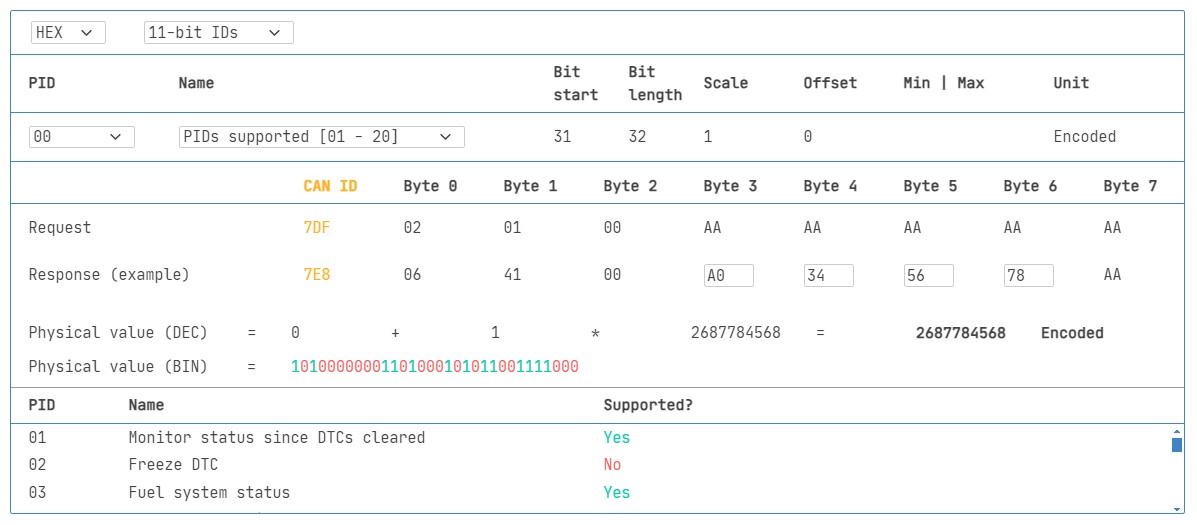 OBD2 PID overview tool
OBD2 PID overview tool
OBD2 PID Overview Tool: A resource for exploring and understanding OBD2 PIDs and their data representation.
OBD2 PID Overview Tool
SAE J1979 and ISO 15031-5 appendices detail scaling information for standard OBD2 PIDs, enabling conversion of raw data to physical values. For quick PID lookups, particularly for mode 0x01, consider using online OBD2 PID overview tools. These tools aid in constructing OBD2 request frames and dynamically decoding responses received via the 16-pin interface.
OBD2 PID overview tool
Logging and Decoding OBD2 Data from the 16-Pin Interface
Let’s explore a practical example of logging OBD2 data using a CANedge CAN bus data logger connected via the 16-pin interface. The CANedge allows configuration of custom CAN frames for transmission, making it suitable for OBD2 data logging.
Connecting the CANedge to your vehicle’s 16-pin OBD2 interface is simplified using an OBD2-DB9 adapter cable.
OBD2 Data Logger Setup: Illustrating a CANedge data logger connected to the 16-pin OBD2 interface for data acquisition.
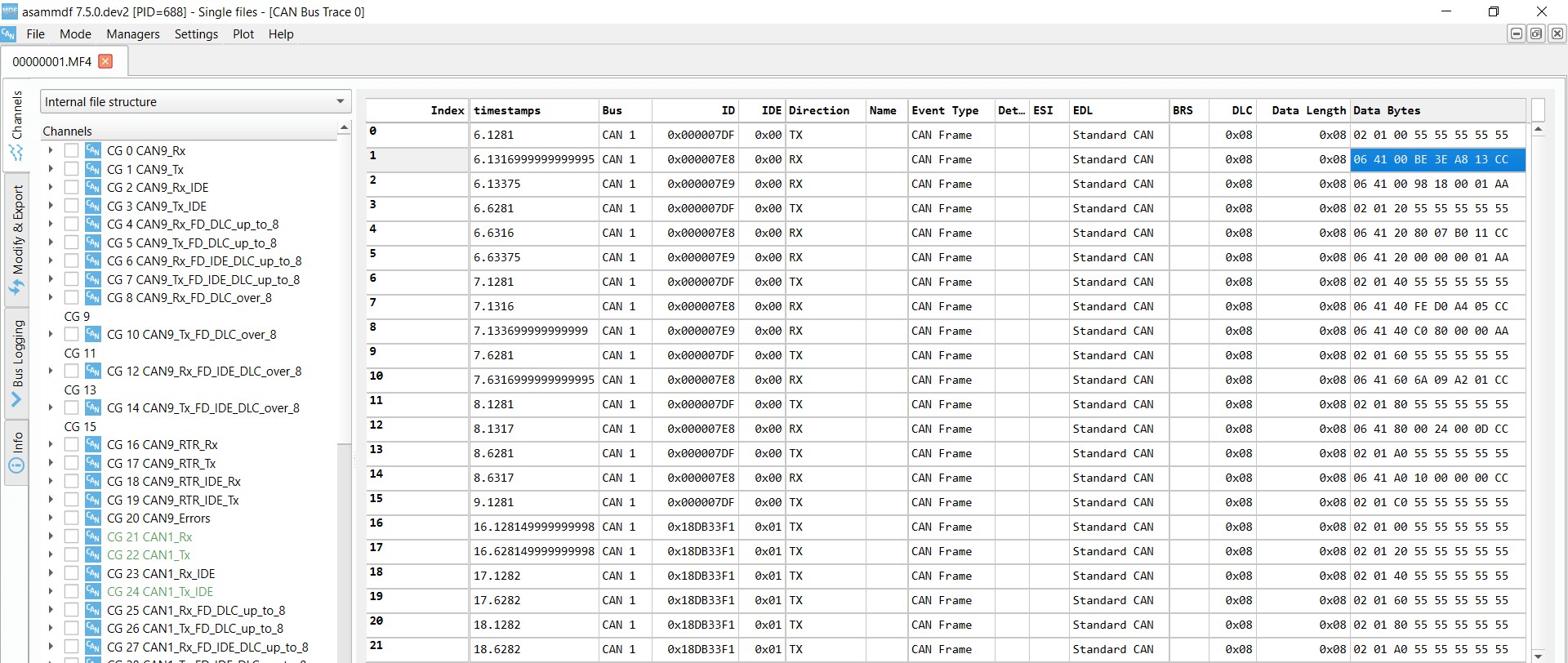 OBD2 Supported PIDs Test Supported PIDs Validation: Reviewing responses to ‘Supported PIDs’ requests to identify available parameters via the 16-pin interface.
OBD2 Supported PIDs Test Supported PIDs Validation: Reviewing responses to ‘Supported PIDs’ requests to identify available parameters via the 16-pin interface.
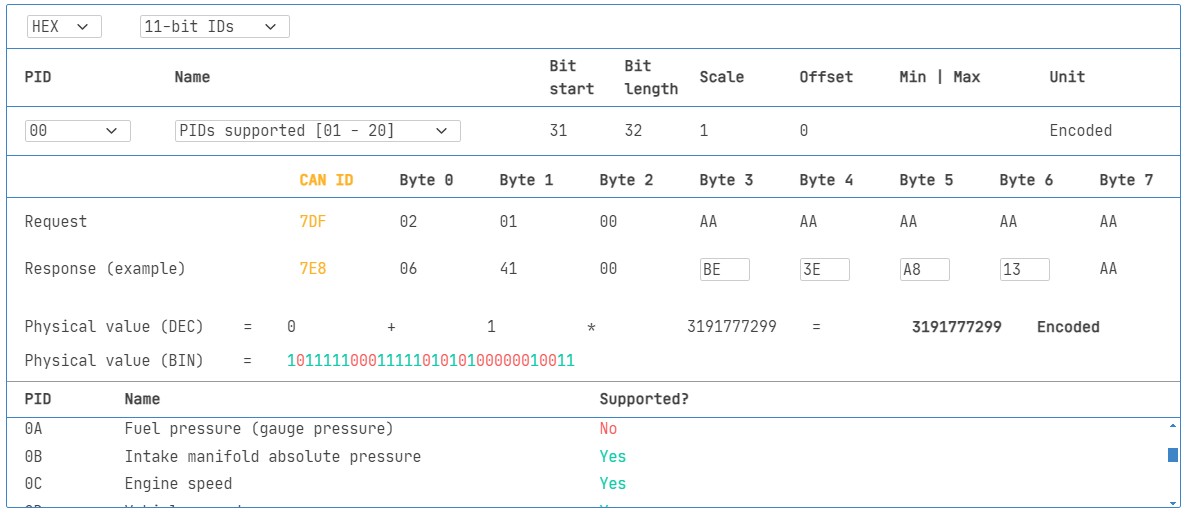 Review supported PIDs via OBD2 lookup tool
Review supported PIDs via OBD2 lookup tool
Step #1: Bit-rate, ID, and Supported PID Validation via the 16-Pin Interface
As per ISO 15765-4, determine the bit-rate and CAN IDs used by your vehicle for OBD2 communication through the 16-pin interface. Use the CANedge for testing:
- Test at 500K bit-rate; if successful, proceed. Otherwise, try 250K.
- Use the identified bit-rate for subsequent communication through the 16-pin interface.
- Send ‘Supported PIDs’ requests and analyze responses.
- Response IDs indicate 11-bit or 29-bit CAN ID usage via the 16-pin interface.
- Response data reveals supported PIDs available through the 16-pin interface.
Pre-configured settings simplify these tests with CANedge. Most 2008+ non-EV cars support 40-80 PIDs using 500K bit-rate, 11-bit CAN IDs, and the OBD2/OBDonEDS protocol via the 16-pin interface.
Multiple responses to a single OBD request (using 0x7DF) are common, as it polls all ECUs. Since all OBD2/OBDonEDS-compliant ECUs must support service 0x01 PID 0x00, numerous responses to this PID are often observed. The ECM ECU (0x7E8) often supports all PIDs supported by other ECUs, suggesting that switching to ‘Physical Addressing’ CAN ID 0x7E0 for subsequent requests can reduce bus load by targeting specific ECU responses via the 16-pin interface.
Step #2: Configuring OBD2 PID Requests via the 16-Pin Interface
Once you know your vehicle’s supported PIDs, bit-rate, and CAN IDs, configure your transmit list to request desired PIDs through the 16-pin interface. Consider these factors:
- CAN IDs: Use ‘Physical Addressing’ request IDs (e.g., 0x7E0) to minimize multiple responses to each request via the 16-pin interface.
- Request Spacing: Introduce 300-500 ms intervals between OBD2 requests to prevent ECU overload and ensure reliable responses via the 16-pin interface.
- Battery Drain: Implement triggers to halt transmission when the vehicle is inactive to avoid unnecessary ECU wake-up and battery drain when connected to the 16-pin interface.
- Data Filtering: Apply filters to record only OBD2 responses, especially if OEM-specific CAN data is also present on the bus accessible via the 16-pin interface.
With these configurations, your device is ready to log raw OBD2 data from the 16-pin interface!
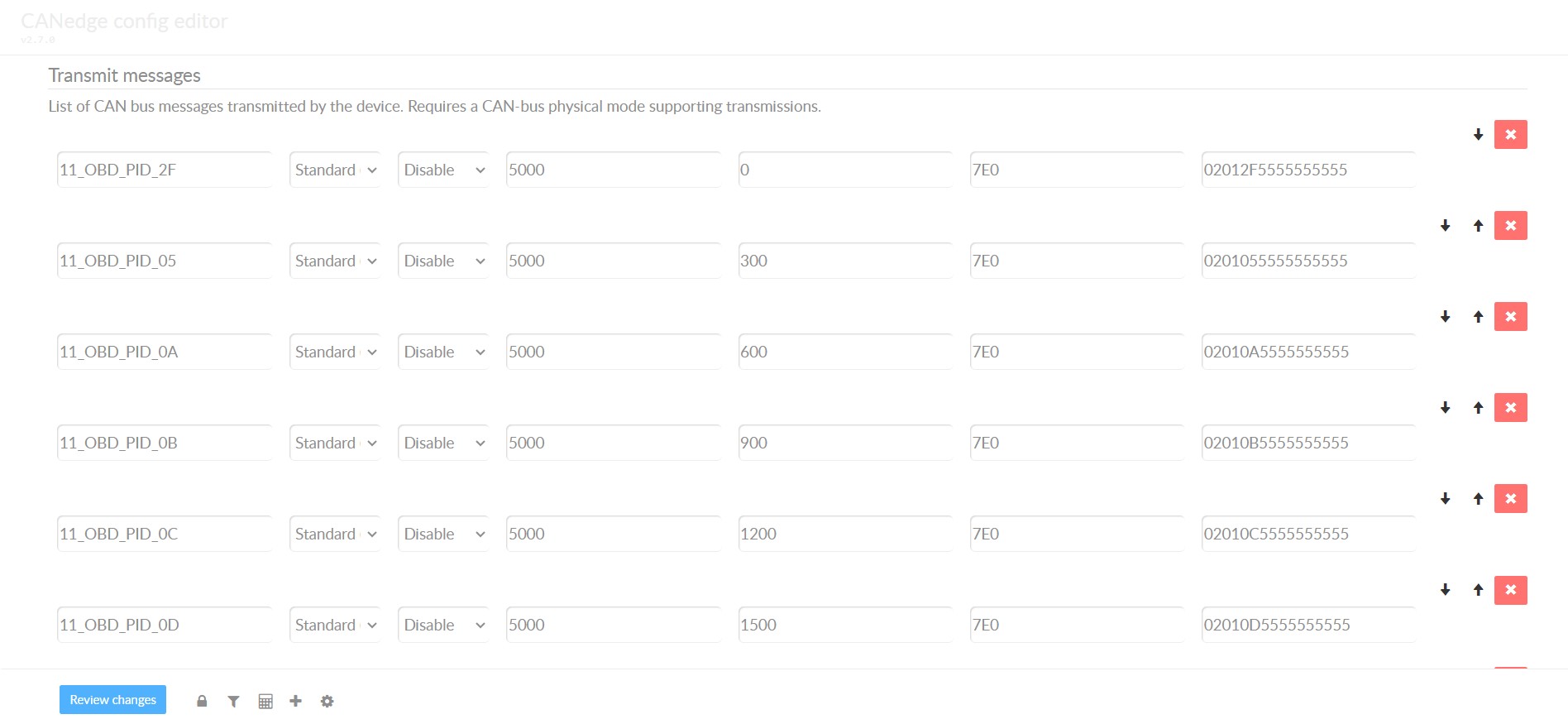 obd2-transmit-list-example-canedge CANedge OBD2 Request List: Example configuration for CANedge, defining a list of OBD2 PID requests to be transmitted via the 16-pin interface.
obd2-transmit-list-example-canedge CANedge OBD2 Request List: Example configuration for CANedge, defining a list of OBD2 PID requests to be transmitted via the 16-pin interface.
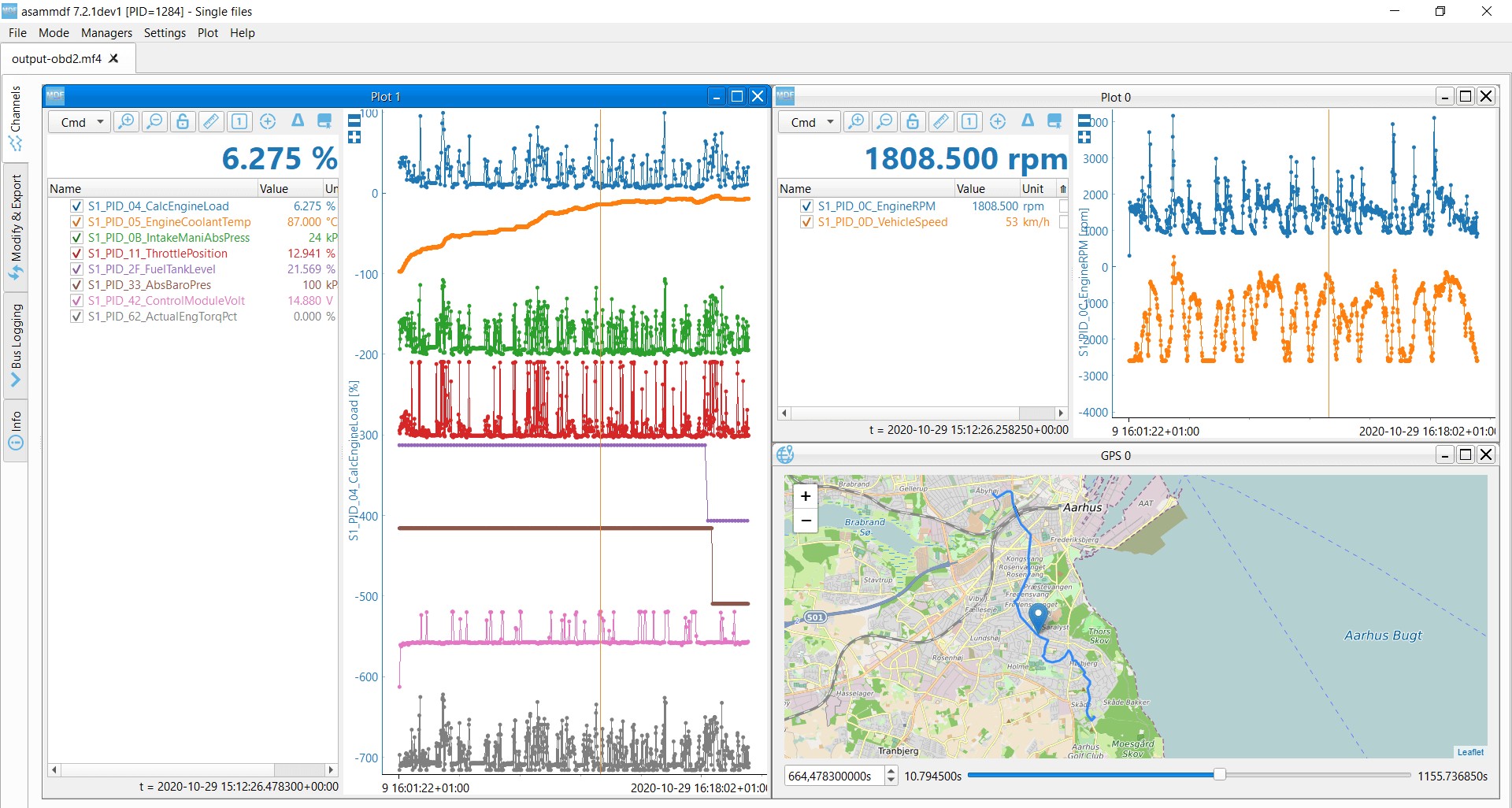 OBD2 data decoded visual plot asammdf CAN bus DBC file asammdf Visualization: Example of DBC decoded and visualized OBD2 data logged via the 16-pin interface, using asammdf software.
OBD2 data decoded visual plot asammdf CAN bus DBC file asammdf Visualization: Example of DBC decoded and visualized OBD2 data logged via the 16-pin interface, using asammdf software.
Step #3: DBC Decoding of Raw OBD2 Data from the 16-Pin Interface
To analyze and visualize logged OBD2 data, decode the raw data into physical values. Decoding information is found in ISO 15031-5/SAE J1979 and online resources like Wikipedia. Utilize a free OBD2 DBC file for easy DBC decoding in CAN bus software tools.
Decoding OBD2 data is more complex than standard CAN signals because different OBD2 PIDs are transmitted using the same CAN ID (e.g., 0x7E8) via the 16-pin interface. CAN ID alone isn’t sufficient for signal identification.
Therefore, signal identification requires considering CAN ID, OBD2 mode, and OBD2 PID. This ‘extended multiplexing’ approach can be implemented in DBC files.
CANedge: Your OBD2 Data Logger via the 16-Pin Interface
The CANedge simplifies OBD2 data recording to an 8-32 GB SD card when connected via the 16-pin interface. Connect it to your vehicle to start logging and decode data using free software/APIs and our OBD2 DBC file.
OBD2 logger intro CANedge
OBD2 Multi-Frame Examples via the 16-Pin Interface [ISO-TP]
While single-frame examples are common, OBD2 also utilizes multi-frame communication via ISO-TP for larger data sets through the 16-pin interface. Multi-frame communication necessitates flow control frames. In practice, a static flow control frame can be transmitted shortly after the initial request frame.
Multi-frame OBD2 responses require CAN software/API tools supporting ISO-TP, like CANedge MF4 decoders.
 OBD2-multi-frame-request-message-vehicle-identification-number
OBD2-multi-frame-request-message-vehicle-identification-number
OBD2 Multi-frame Request Example: Requesting the Vehicle Identification Number (VIN) via the 16-pin interface, requiring multi-frame communication.
Example 1: OBD2 Vehicle Identification Number (VIN) Retrieval via the 16-Pin Interface
Retrieving the VIN, often crucial for telematics and diagnostics, utilizes OBD2 mode 0x09 and PID 0x02 via the 16-pin interface.
 VIN Vehicle Identification Number OBD2 Example multi-frame
VIN Vehicle Identification Number OBD2 Example multi-frame
The tool sends a Single Frame request with PCI field (0x02), service identifier (0x09), and PID (0x02). The vehicle responds with a First Frame containing PCI, length, mode (0x49), and PID (0x02). Following the PID is the Number Of Data Items (NODI), and the remaining 17 bytes represent the VIN, which can be decoded from HEX to ASCII.
Example 2: OBD2 Multi-PID Request (6x) via the 16-Pin Interface
External tools can request up to 6 mode 0x01 OBD2 PIDs in a single request frame via the 16-pin interface. The ECU responds with data for supported PIDs, potentially using multi-frame responses.
While efficient, this method complicates signal encoding, making generic DBC files less suitable. We generally advise against this approach.
 Requesting multiple PIDs in one request
Requesting multiple PIDs in one request
Decoding multi-PID responses via generic DBC files is challenging due to payload structure variability. Custom scripts and recording request messages can aid in interpretation, but scaling such approaches can be difficult.
Example 3: OBD2 Diagnostic Trouble Codes (DTCs) Retrieval via the 16-Pin Interface
OBD2 mode 0x03 (‘Show stored Diagnostic Trouble Codes’) retrieves emissions-related DTCs via the 16-pin interface. No PID is included in the request. The ECU responds with the number of stored DTCs and the DTCs themselves, with each DTC occupying 2 bytes. Multi-frame responses are necessary for more than 2 DTCs.
The 2-byte DTC value is categorized and encoded into a 4-digit hexadecimal code. Decoded DTC values can be looked up in OBD2 DTC lookup tools.
OBD2 DTC Decoding Example: Illustrating the structure and interpretation of Diagnostic Trouble Codes retrieved via the 16-pin interface.
 OBD2 Diagnostic Trouble Codes DTC CAN Bus Request Response Example
OBD2 Diagnostic Trouble Codes DTC CAN Bus Request Response Example
OBD2 Data Logging Use Cases via the 16-Pin Interface
OBD2 data, accessed through the 16-pin interface, has diverse applications:
Car Data Logging:
OBD2 data logging can optimize fuel consumption, improve driving habits, facilitate prototype testing, and inform insurance assessments by leveraging data from the 16-pin interface.
obd2 logger
Real-time Car Diagnostics:
OBD2 interfaces enable real-time streaming of human-readable diagnostic data for immediate issue identification via the 16-pin interface.
obd2 streaming
Predictive Maintenance:
IoT OBD2 loggers can remotely monitor vehicles, predicting and preventing breakdowns through cloud-based analysis of data obtained via the 16-pin interface.
predictive maintenance
Vehicle Blackbox Logger:
OBD2 loggers can function as vehicle ‘black boxes’, recording data for incident analysis, dispute resolution, and detailed diagnostics, all initiated through the 16-pin interface.
can bus blackbox
Have an OBD2 data logging application in mind? Contact us for expert guidance!
Contact us
Explore our guides section for more introductions or download the comprehensive ‘Ultimate Guide’ PDF.
Ready to log or stream OBD2 data?
Get your OBD2 data logger today!
Buy now Contact us
Recommended Resources
OBD2 DATA LOGGER: EASILY LOG & CONVERT OBD2 DATA
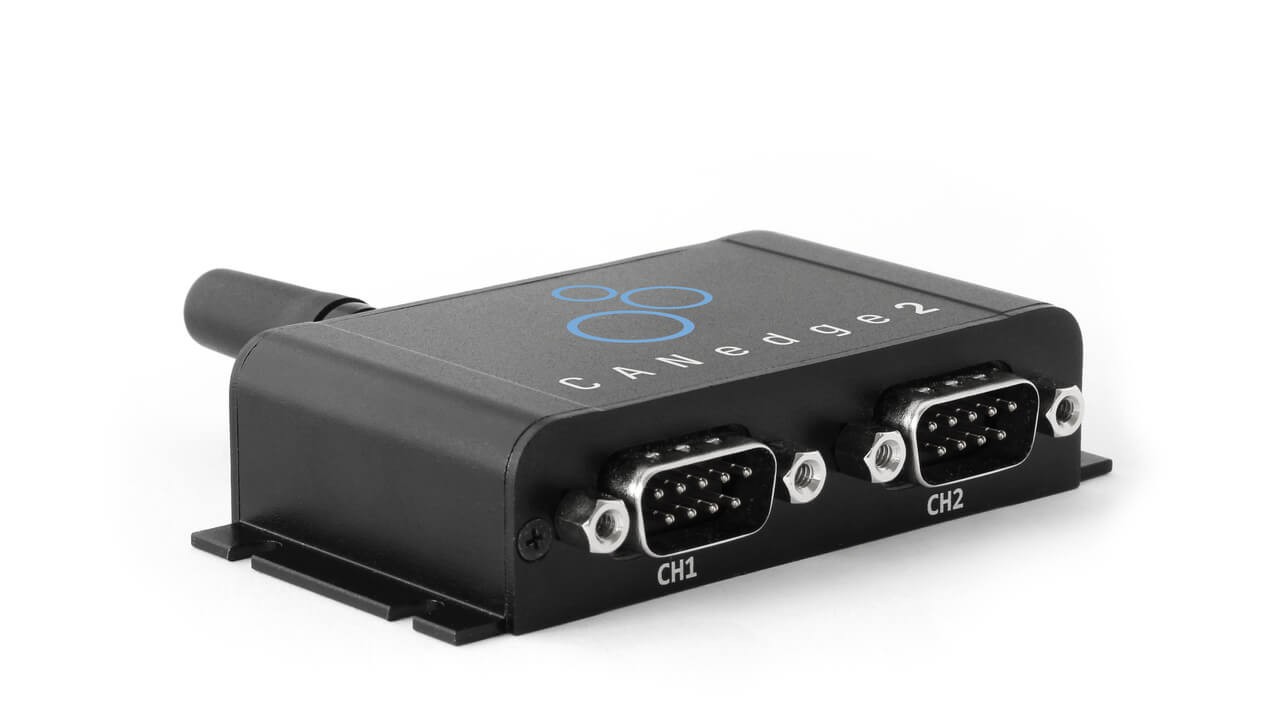 CANedge2 – Dual CAN Bus Telematics Dongle CANEDGE2 – PRO CAN IoT LOGGER
CANedge2 – Dual CAN Bus Telematics Dongle CANEDGE2 – PRO CAN IoT LOGGER
[